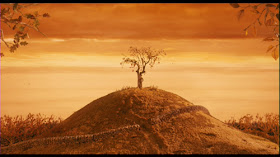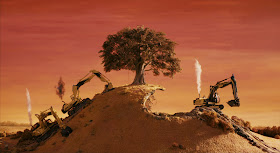Here, I try to assemble a fragmentary meandering on referenced sources, some of them cited as inspiration by the director, some of them my own guess-work. Down below I have included Google Video for the first time (just excerpts from music, though).
 |
| early depiction of vested fox |
Unlike
Jeffrey Katzenberg, for example,
Wes Anderson does not believe in drowning his films in pop cultural references of the day. If you look for them, you can find a lot of references in his films, but you never have to recognize them to enjoy a scene and – at least, that’s what I think – all of them have stood the test of time and will not seem dated in future decades. I experience them rather as an extra layer of meaning beneath the surface.
Foxes wearing clothes and walking on their hind legs have a long tradition in illustration. The Story of ”Reineke Fuchs” or “Reynard the Fox” dates back to medieval European folklore, with even older origins in fables. In these stories the fox is a sly trickster and successfully plays the other animal characters off against each other – which he gets away with in the end.
Especially in the German-speaking part of Europe
Goethe’s poem about “Reineke Fuchs” is well-known and has inspired many illustrations. During the 19th century, illustrators like
Heinrich Kley,
Gustave Doré, John Tenniel, John Swain or
Wilhelm von Kaulbach have drawn anthropomorphic animals.
 |
| Wilhelm von Kaulbach (Reineke Fuchs, 1857) |
 |
| John Swain (Punch, 1883) |
When asked about inspiration for his stop-motion-feature
Fantastic Mr. Fox Wes Anderson frequently cites
Ladislas and Irène Starevitch’s 1930 feature of the French version of the story called
Le Roman de Renard. With a length of 65 minutes it is one of the few pre-
Snow White animated features. However, it hadn’t found its way into cinemas until the Nazis showed a German language version in 1937. It only hit French screens during the war in 1941.

The black and white stop motion film connects episodes of Renard’s bad deeds by having the aggrieved victims tell the lion king of their suffering. Compared to what we are used to see in children’s films today it has a real wild story including a extra-marital romance of the lion queen with a singing cat. In the end, the fox is even able to talk himself off the gallows so that the king decides to make peace and elevate the fox to become his minister. It is
on youtube in full length with English subtitles.
Its creator, the then-renowned Ladislas Starevitch (or Ladislaw Starewicz), was originally Polish. Seeing the animation style in Wes Anderson’s film, it is not surprising that a lot of key inspiration was Eastern European stop-motion animation, especially Hungarian.
 |
| Burl Ives as Sam the Snowman |
Anderson also mentioned the
Rankin-Bass christmas special
Rudolph the Red-Nosed Reindeer in which
Burl Ives plays a singing onscreen narrator called Sam the Snowman. There are at least three Burl Ives songs playing during interior scenes of
Fantastic Mr. Fox. All of them are from 1949 and can be found
on a pair of records with songs for children (the same year Ives was nominated for an Academy Award for a song he sang as Uncle Hiram in Disney’s
So Dear To My Heart). According to Wikipedia these children’s records coincide with the birth of his own song. It’s not unexpected that Burl Ives records can be heard mainly in Ash’s room and at the family table.
 |
| Two of the scenes accompanied by Burl Ives records |
 |
| Jarvis Cocker as Petey |
All of these songs were recorded before he was blacklisted by and then cooperated with the HUAC causing a rift with fellow folk singer
Pete Seeger. Without thinking about this connection (and I’m really just guessing here) I’ve understood the banjo playing character Petey as a homage to Pete Seeger despite
Jarvis Cocker being English like all humans are in contrast to the all-American animals. Yet making him an onscreen character who supposedly, at one point, was meant to become an onscreen narrator, too, there’s also a resemblance to Ives’ snowman character in
Rudolph. Throw in cousin Kristofferson who is allegedly named after
Kris Kristofferson and you get a blend of different folk musicians that probably doesn’t literally mean anything but nevertheless triggers a wide range of associations.
Talking about vested foxes one cannot ignore
Woolie Reitherman’s Robin Hood (1973). Anderson, born in 1969, must have seen this as a child and he uses its song “Love” in an idyllic scene outside the treehouse. It’s barely audible, but it’s playing like a piece of mood music.
 |
| The record playing in this scene is from Robin Hood. |
According to
Robin Allan,
“Ken Anderson wept when he saw how his character concepts had been processed into stereotypes for the animation on Robin Hood”. By then, the film makers had eradicated any interesting character trait that might have been left over from the original Reynard character. All that was left were the clothes and hunter’s hat. But animating the real story of “Reynard” was in talks as early as 1937, even before
Disney could have seen the Starevitch feature. According to
Charles Solomon (The Disney that never was, p. 81ff), Disney
“expressed reservations about the personality of the title character: ‘Well, our main character is a crook, and there’s nothing about him having the ‘Robin Hood’ angle. […] He’s not to be a murderer under any circumstances. He shouldn’t take advantage of anybody but a stupid individual.’”
He further cited his problems with the Hays Office because of
Cock Robin. Later, it was to be combined with "Chanticleer" and under discussion until the 1960s. Its later character design
“provided a jumping-off point for the artists when they made Robin Hood” (Solomon).
 |
| "Reynard attempts to woo a demure old hen", drawing for Chanticleer by Marc Davis (in Charles Solomon's "The Disney that never was", p.82) |
See also: Chanticleer and fox by Jeffrey Pepper and Robin Hood confidential by Will Finn.
Musically, there is a wealth of references with
Alexandre Desplat’s brilliant score weaving such disparate sources as
Beach Boys, Burl Ives, Truffaut soundtracks and
Morricone imitations together into one seamless fabric that is dominated by banjo and chimes.
As always with Wes Anderson, there is a
Rolling Stones song playing during a key scene. Using songs of the late 1960s, early 1970s is one of the director’s trademarks. Here they fit perfectly, since the film seems to take place around the year 1970 when the book came out.
Mr. Fox’ confrontations with the farmers, Bean’s security rat and the wolf are successfully staged like
Sergio Leone shootouts. Since these spaghetti western spoofs have become an annoying staple of so many comedies, it’s positively surprising when one is really working. A lot of its success is due to the perfect musical timing and scoring.
I have juxtaposed three of Desplat’s sound cues with Ennio Morricone’s originals they reminded me of.
All the Western-soundalikes are based on the film's signature tune, the children’s choir nursery rhyme about “Boggis, Bunce and Bean” (see/hear excerpt below):
Coming soon: Wes Anderson’s visual style









































